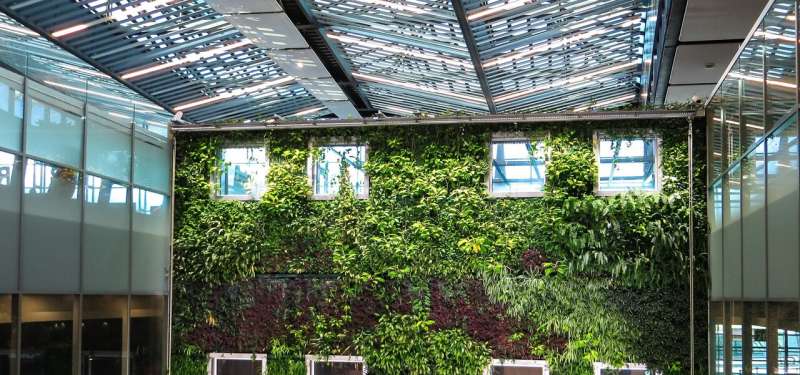How do we design buildings that enable occupants to thrive?

Americans spend 87 percent of their time indoors, according to the U.S. Environmental Protection Agency.
Unfortunately, many buildings contribute to depression, stress, poor health and absenteeism, say Stanford engineers Sarah Billington and James Landay. Cut off from fresh air, sunlight and any hint of nature, many office workers are surrounded by fluorescent glare, artificial materials and random noise.
Billington and Landay are leading an interdisciplinary research project on using architectural and digital innovations to change that. Better building designs could include new ways to bring the outdoors inside, such as with modular "plant walls" and other natural materials. Digital features might include lighting that mimics sunlight streaming through a forest. The two discussed their work in a recent presentation. Below are highlights.
What's the problem with office buildings?
Landay: Look around you at work or school. Many people are unhappy, overstressed and overweight. Others feel unmotivated or isolated. Why? One reason is that the office environment is often noisy and artificial, with no hint of nature. That can make people feel anxious and distracted, which undermines their performance and an organization's productivity. Absenteeism—when healthy employees call in sick—is estimated to cost U.S. companies $226 billion a year. One study showed that offices lacking nature could account for 10 percent of that cost, or as much as $23 billion a year. Winston Churchill once wrote: "We shape our buildings; thereafter they shape us." What if we could design buildings to shape us in positive ways?
How do you propose to improve things?
Billington: We can start with what we know: A connection to nature lowers blood pressure and heart rates, and improves mental engagement and mood. Studies also show, for instance, that hospital patients recover faster if they have a view of nature. In offices and schools, natural lighting can improve concentration and productivity. One strategy is to bring nature indoors. Modular green walls can be designed to support natural ventilation in a wider range of climates, bringing both fresh air and nature inside. A nascent movement is forming around concepts like these to support well-being, but there have been few controlled experiments over the long term to support these ideas.
What does that mean?
Landay: Future offices are going to be hybrid physical and digital spaces. Video displays will come down in cost and require little power, leading to their deployment throughout buildings. Eventually, window glass will have the digital capabilities to change lighting or become another display. Imagine a large display in an office hallway that shows a dynamic mural of flowers blowing in the wind. Individuals will be encouraged to follow the flowers down the hall, in the direction of the stairs instead of the elevator.
Billington: We can also use architectural design to mimic aspects of nature inside a building and potentially give people the benefits. Dappled sunlight changing during the day and organic forms representing nature are examples.
How do you measure well-being, and figure out whether a building is improving it?
Landay: That's what our research is about. We focus on measuring several key things: stress, a sense of belonging, creativity, physical activity, and pro-environmental behavior. We can start by asking people how they're feeling. But, unfortunately, people have trouble accurately recalling things when self-reports are taken on a daily or weekly basis. Experience sampling method, or ESM, is a more accurate way of taking self-reports. With ESM you ask one quick question several times throughout the day; for example, how are you feeling now? We can also use apps that let people opt in to use their phones, watches and laptops to collect physical activity and stress data. We'd match these measures of well-being against other data that buildings can already collect on air quality, sound, lighting, occupancy and energy use. By putting all this information together, we can learn more about which adaptations increase occupant well-being.
What about the costs of all this?
Billington: Improving buildings for well-being may be more valuable than you'd assume. About 90 percent of a commercial building's operating costs are tied to staff salaries and benefits. If architectural and digital changes can even modestly improve people's well-being and productivity, these improved designs could yield big returns on investment. Our research will inform strategies for high impact in new building designs going forward. For existing buildings, structural changes may be cost-prohibitive, but less expensive non-structural and digital adaptations can do a lot to enhance well-being.
Where do you see all this leading?
Landay: Buildings of the future are going to have both sensing and actuation. The idea is to use sensing, plus machine learning, to infer the state of people, whether they are depressed, angry or happy, and then actuate changes in the building's environment and displays to enhance mood and health. The key is to do this in a human-centered way that is privacy preserving and, to put it simply, doesn't feel creepy. People have to be comfortable with this sensing, opt in about what information is being sensed, and have the ability to delete it or not participate at all. We still have a lot to learn about how to do this well, but it's clear that buildings can be healthier for us than they are now. Our goal through this research is to help make our built environment a place where people will thrive and flourish.




















